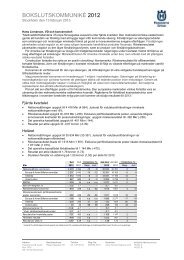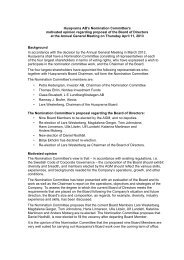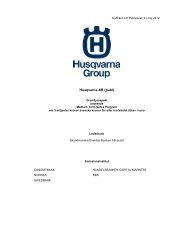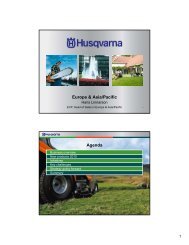Annual Report 2009 - Husqvarna Group
Annual Report 2009 - Husqvarna Group
Annual Report 2009 - Husqvarna Group
Create successful ePaper yourself
Turn your PDF publications into a flip-book with our unique Google optimized e-Paper software.
Notes <strong>Husqvarna</strong> <strong>Annual</strong> <strong>Report</strong> <strong>2009</strong> 57<br />
Amounts in SEKm unless otherwise stated.<br />
IFRS 7, “Financial instruments – Disclosures” (amendment) –<br />
effective 1 January <strong>2009</strong>. The amendment requires enhanced<br />
disclosures about fair value measurement and liquidity risk. In<br />
particular, the amendment requires disclosure of fair value<br />
measurements by level of a fair value measurement hierarchy.<br />
The change in accounting policy results in additional disclosures<br />
in note 2 “Financial risk management and financial<br />
instruments”.<br />
IFRS 8, Operating segments. The standard is effective for<br />
financial years, beginning on or after 1 January <strong>2009</strong>. The<br />
standard addresses the division of the Company’s operations<br />
into different segments. According to the standard, the Company<br />
is to base this division on its internal reporting structure<br />
and is to determine the reportable segments on the basis of<br />
this structure. <strong>Husqvarna</strong> has evaluated this standard and it<br />
has had no impact on the <strong>Group</strong>’s reportable segments compared<br />
to previous years. <strong>Husqvarna</strong> will, however, change its<br />
reportable segments as of 1 January 2010. For more information,<br />
see page 15.<br />
IAS 23, Borrowing costs (Revised). The main change from the<br />
previous version is the removal of the option of immediately<br />
recognizing as an expense borrowing costs that relate to<br />
assets that take a substantial period of time to prepare for use<br />
or sale. <strong>Husqvarna</strong> has earlier expensed borrowing costs for<br />
such assets as they arise. <strong>Husqvarna</strong> has therefore changed<br />
accounting policies and capitalize borrowing costs as part of<br />
the cost of such assets.<br />
IFRIC 14, IAS 19: The Limit on a Defined Benefit Asset, Minimum<br />
Funding Requirements and their interaction. IFRIC 14<br />
addresses three issues: how entities should determine the<br />
limit placed by IAS 19, Employee Benefits, on the amount of a<br />
surplus in a pension plan they can recognize as an asset: how<br />
a minimum funding requirement affects that limit; when a<br />
minimum funding requirement creates an onerous obligation<br />
that should be recognized as a liability in addition to that otherwise<br />
recognized under IAS 19.<br />
New accounting principles from 2010 and onwards<br />
A number of standards, interpretations and amendments will<br />
come into effect 2010. The <strong>Group</strong> has or is in the process of<br />
evaluating the complete effect of the implementation of<br />
these changes. The following standards are those expected<br />
to have an impact on the <strong>Group</strong> accounts.<br />
IAS 27, (Revised). “Consolidated and separate financial statements”,<br />
(effective from 1 July <strong>2009</strong>). The revised stand ard<br />
requires the effects of all transactions with non controlling<br />
interests to be recorded in equity if there is no change in control<br />
and these transactions will no longer result in goodwill or<br />
gains and losses. The standard also specifies the accounting<br />
when control is lost. Any remaining interest in the entity is<br />
re-measured to fair value and a gain or loss is recognised in<br />
profit or loss. The <strong>Group</strong> will apply IAS 27 (Revised) prospectively<br />
to transactions with non-controlling interests from<br />
1 January 2010.<br />
IFRS 3, (Revised). “Business combinations” (effective from<br />
1 July <strong>2009</strong>). The revised standard continues to apply the<br />
acquisition method to business combinations, with some significant<br />
changes. For example, all payments to purchase a<br />
business are to be recorded at fair value at the acquisition<br />
date, with contingent payments classified as debt subsequently<br />
re-measured through the income statement. There is<br />
a choice on an acquisition-by-acquisition basis to measure the<br />
non-controlling interest in the acquiree either at fair value or<br />
at the non-controlling interest’s proportionate share of the<br />
acquiree’s net assets. All acquisition-related costs should be<br />
expensed. The <strong>Group</strong> will apply IFRS 3 (Revised) prospectively<br />
to all business combinations from 1 January 2010.<br />
Significant accounting policies and<br />
uncertainty factors in estimated value<br />
Use of estimates<br />
Management has made a number of estimates and assumptions<br />
relating to the reporting of assets and liabilities and the<br />
disclosure of contingent assets and liabilities in order to prepare<br />
these financial statements in conformity with generally<br />
accepted accounting principles. Actual results could differ<br />
from these estimates.<br />
The discussion and analysis of <strong>Husqvarna</strong>’s results of operations<br />
and financial position are based on <strong>Husqvarna</strong>’s financial<br />
statements, which have been prepared in accord ance with<br />
International Financial <strong>Report</strong>ing Standards (IFRS), as adopted<br />
by the European Union. The preparation of these financial<br />
statements requires management to apply certain accounting<br />
methods and policies that may be based on difficult, complex<br />
or subjective judgments. Management applies estimates on<br />
the basis of experience and assumptions determined to be<br />
reasonable and realistic based on the related circumstances.<br />
The application of these estimates and assumptions affects<br />
the reported amounts of assets and liabilities and the disclosure<br />
of contingent assets and liabilities at balance sheet date<br />
and also affects the reported amounts of net sales and<br />
expenses during the reporting period. Actual results may differ<br />
from these estimates under different assumptions or conditions.<br />
Summarized below are those accounting policies that<br />
require more subjective judgment from management in making<br />
assumptions or estimates regarding the effects of matters<br />
that are inherently uncertain.<br />
Asset impairment<br />
All assets with long useful lives, including goodwill, are evaluated<br />
for impairment yearly or whenever events or changes in<br />
circumstances indicate that the carrying amount of an asset<br />
may not be recoverable. An impaired asset is written down to<br />
its recoverable amount on the basis of the best information<br />
available. Different methods have been used for this evaluation,<br />
depending on the availability of information. When available,<br />
market value has been used and impairment charges<br />
have been recorded when this information has indicated that<br />
the carrying amount of an asset is not recoverable. If market<br />
value has not been available fair value has been estimated by<br />
using the discounted cash flow method based on expected

















